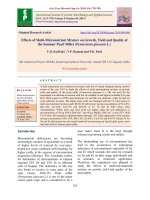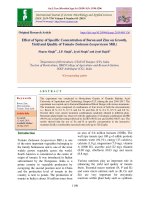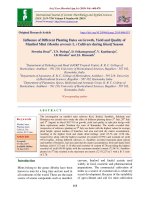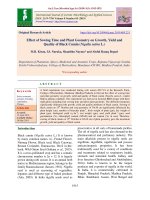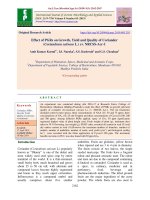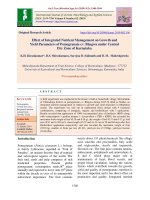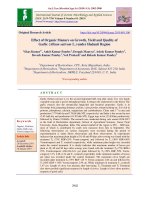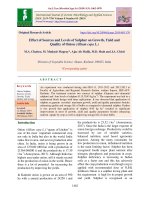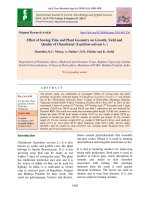Effect of integrated nutrient modules on growth, yield and quality parameters of banana cv. Grand Naine
Bạn đang xem bản rút gọn của tài liệu. Xem và tải ngay bản đầy đủ của tài liệu tại đây (348.11 KB, 11 trang )
Int.J.Curr.Microbiol.App.Sci (2018) 7(1): 1974-1984
International Journal of Current Microbiology and Applied Sciences
ISSN: 2319-7706 Volume 7 Number 01 (2018)
Journal homepage:
Original Research Article
/>
Effect of Integrated Nutrient Modules on Growth, Yield and Quality
Parameters of Banana cv. Grand Naine
T. Ganapathi* and P.R. Dharmatti
Department of Horticulture, University of Agricultural Sciences, Dharwad-580 005,
Karnataka, India
*Corresponding author
ABSTRACT
Keywords
Banana, INM,
Nutrient module,
Soil properties and
NPK content in
plant
Article Info
Accepted:
14 December 2017
Available Online:
10 January 2018
A field experiment was conducted at new orchard, Department of Horticulture, University
of Agricultural Sciences, Dharwad during 2014-15 and 2015-16 on “Integrated nutrient
management studies in banana cv. Grand Naine (AAA)” through application of different
combination of organic manures and inorganic fertilizers with green manure, Azospirillum
and PSB. The results revealed that, Vermicompost equivalent to 40 % RDN (24.20 t/ha) +
Urea equivalent to 40 % RDN (535.73 kg/ ha) + Green manure (sunnhemp @ 8.88 t/ha)
and Azospirillum (@ 30.86 kg/ha) equivalent to 20 % RDN + PSB (@ 30.86 kg/ha) (T 7)
recorded the highest growth parameters [pseudostem height (205.05cm), pseudostem girth
(27.47cm), number of leaves (16.00), leaf area (8.87 m2), leaf area index (2.74), the least
number of days taken for shooting (190.65) and total crop duration(318.89)], yield
parameters [bunch weight (26.94 kg), number of hands per bunch (11.75), finger weight
(137.38 g), finger length (17.75 cm), plot yield (85.57 kg), yield per ha (66.02 t)] and
quality parameters [TSS (23.520 brix), total sugars (20.30%), reducing sugars (20.30 %),
non-reducing sugars (17.87%), pulp to peel ratio (3.81) shelf life (6.33 days) and the least
starch (3.67 %) and titrable acidity (0.25)] followed by T 10 (Agrigold combination) and T 11
(Bhumilabh combination) treatments.
Introduction
In India, banana is cultivated in an area of
0.83 million ha with a production of 30
million tonnes (Anon., 2011).
The major banana growing areas are in Tamil
Nadu, Maharashtra, Andhra Pradesh, Gujarat,
Kerala, Karnataka, West Bengal and Orissa. It
is being grown in an area of 1.12 lakh ha with
a production of 2.28 lakh tonnes in Karnataka
state.
Banana is known to consume more nutrients
for its growth, yield and biomass production
(Hazarika et al., 2015).
The use of chemical fertilizers alone has
deleterious effect on soil physical, chemical
and biological properties and productivity in
the long run. The availability of organic
manures is also one of the limitations for use
in banana production. To fulfil the nutrient
requirement only through organic or inorganic
or bio- fertilizers alone is seldom possible but
1974
Int.J.Curr.Microbiol.App.Sci (2018) 7(1): 1974-1984
integration of all these sources will not only
aid in achieving higher yields but also in
sustaining the soil fertility status in the long
run.
Materials and Methods
The field experiment with an integrated
nutrient module consisting of organic
manures, chemical fertilizers, green manure
and bio-fertilizers in banana cv. Grand Naine
was conducted during 2014-15 and 2015-16 at
new orchard, Department of Horticulture,
University of Agricultural Sciences, Dharwad.
The soil type was red with clay texture.
The experiment consists of 12 treatments viz.
Plant crop
T1- FYM equivalent to 40 % RDN (48.40 t/ha)
+ VC equivalent to 40 % RDN (24.20 t/ha) +
GM (Sunnhemp @ 8.88 t/ha) and Azospirillum
(30.86 kg/ha) equivalent to 20 % RDN + PSB
(30.86 kg/ha).
T2 -FYM equivalent to 40 % RDN (48.40 t/ha)
+ PM equivalent to 40 % RDN (8.96 t/ha) +
GM (Sunnhemp @ 8.88 t/ha) and Azospirillum
(30.86 kg/ha) equivalent to 20 % RDN + PSB
(30.86 kg/ha).
T3- FYM equivalent to 40 % RDN (48.40 t/ha)
+ SM equivalent to 40 % RDN (10.17 t/ha) +
GM (Sunnhemp @ 8.88 t/ha) and Azospirillum
(30.86 kg/ha) equivalent to 20 % RDN + PSB
(30.86 kg/ha).
T4- FYM equivalent to 40 % RDN (48.40 t/ha)
+ AG equivalent to 40 % RDN (10.52 t/ha) +
GM (Sunnhemp @ 8.88 t/ha) and Azospirillum
(30.86 kg/ha) equivalent to 20 % RDN + PSB
(30.86 kg/ha).
T5- FYM equivalent to 40 % RDN (48.40 t/ha)
+ BL equivalent to 40 % RDN (7.56 t/ha) +
GM (Sunnhemp @ 8.88 t/ha) and Azospirillum
(30.86 kg/ha) equivalent to 20 % RDN + PSB
(30.86 kg/ha).
T6- FYM equivalent to 40 % RDN (48.40 t/ha)
+ 40 % RDN through chemical fertilizer (Urea
535.73 kg/ ha) + GM (Sunnhemp @ 8.88 t/ha)
and Azospirillum (30.86 kg/ha) equivalent to
20% RDN + PSB (30.86 kg/ha).
T7- VC equivalent to 40 % RDN (24.20 t/ha) +
40 % RDN through chemical fertilizer (Urea
535.73 kg/ ha) + GM (Sunnhemp @ 8.88 t/ha)
and Azospirillum (30.86 kg/ha) equivalent to
20 % RDN + PSB (30.86 kg/ha).
T8- PM equivalent to 40 % RDN (8.96 t/ha) +
40 % RDN through chemical fertilizer (Urea
535.73 kg/ ha) + GM (Sunnhemp @ 8.88 t/ha)
and Azospirillum (30.86 kg/ha) equivalent to
20 % RDN + PSB (30.86 kg/ha).
T9- SM equivalent to 40 % RDN (10.17 t/ha) +
40 % RDN through chemical fertilizer (Urea
535.73 kg/ ha) + GM (Sunnhemp @ 8.88 t/ha)
and Azospirillum (30.86 kg/ha) equivalent to
20 % RDN + PSB (30.86 kg/ha).
T10- AG equivalent to 40 % RDN (10.52 t/ha)
+ 40 % RDN through chemical fertilizer (Urea
535.73 kg/ ha) + GM (Sunnhemp @ 8.88 t/ha)
and Azospirillum (30.86 kg/ha) equivalent to
20 % RDN + PSB (30.86 kg/ha)
T11- BL equivalent to 40 % RDN (7.56 t/ha) +
40 % RDN through chemical fertilizer (Urea
535.73 kg/ ha) + GM (Sunnhemp @ 8.88 t/ha)
and Azospirillum (30.86 kg/ha) equivalent to
20 % RDN + PSB (30.86 kg/ha)
T12 -Control (RDF 200: 100: 300 g NPK /plant
or 617.20:308.60: 925.80 kg NPK/ha + Farm
yard manure@ 40 t/ha)
The recommended dose of phosphorous and
potash (100 g/plant and 300 g/plant
1975
Int.J.Curr.Microbiol.App.Sci (2018) 7(1): 1974-1984
respectively) was supplied through DAP and
MOP.
Ratoon crop
RDF = 100:50:100 NPK g /plant or
308.60:154.20: 308.60 kg NPK/ha) + FYM @
20 t/ha
Note: 1) FYM- Farm Yard Manure, VCVermicompost, PM-Poultry Manure, SMSheep Manure, AG-Agrigold, BL-Bhumilabh,
GM-Green
manure,
PSB-Phosphate
Solubilizing bacteria. Azospirillum (ACD-15)
and PSB (Pseudomonas striata) were used for
the study.
The application of organic manures, chemical
fertilizers with green manure and bio-fertilizer
will compensate the majority of the plant
nutrition thereby increase the productivity of
banana cv. Grand Naine. The influence of
integrated nutrient module was assessed on
growth, yield and quality parameters of
banana. The results of the field experiments
conducted during the year 2014-15 and 201516 are pooled and discussed.
Results and Discussion
The results of the field experiments conducted
during the year 2014-15 and 2015-16 are
pooled and discussed under different headings.
Effect of integrated nutrient modules on
banana growth parameters (Table 1 and 2)
The influence of different integrated nutrient
modules on growth parameters which caused
the yield variations are discussed here under.
The results of the pooled mean indicated that,
at shooting the highest plant height (205.05
cm) was recorded in T7 {Vermicompost
equivalent to 40 % RDN (24.20 t/ha) +
Chemical fertilizer (Urea 535.73 kg/ ha)
equivalent to 40 % RDN + Green manure
(sunnhemp @ 8.88 tons/ha) and Azospirillum
(30.86 kg/ha) equivalent to 20 % RDN + PSB
(30.86 kg/ha)} which was on par with T6, T10
and T11 and significantly superior over rest of
the treatments. The least pseudostem height
was recorded in T8 (171.53 cm) followed by
T3. The pseudostem girth was significantly
higher with T7 treatment (27.47 cm) followed
by T9 which was on par with T1, T4, T5, T6, T9,
T10, T11 and T12 and the least pseudostem girth
(24.99 cm) was recorded in plants treated with
T8. The highest number of leaves (16.00) was
recorded in T7 {Vermicompost equivalent to
40 % of RDN (24.20 t/ha) + Chemical
fertilizer (Urea 535.73 kg/ ha) equivalent to 40
% RDN + Green manure (sunnhemp @ 8.88
tons/ha) and Azospirillum (30.86 kg/ha)
equivalent to 20 % RDN + PSB (30.86
kg/ha)} indicating the superiority of integrated
nutrient module over organic treatments alone
which was significantly superior over all other
treatments except T3 and T8. The least number
of leaves (13.24) was recorded in T8 (Table 1).
The application vermicompost equivalent to
40 % RDN (24.20 t/ha) + Chemical fertilizer
(Urea 535.73 kg/ ha) equivalent to 40 % RDN
+ Green manure (sunnhemp @ 8.88 tons/ha) +
Azospirillum (30.86 kg/ha) equivalent to 20 %
RDN + PSB (30.86 kg/ha) (T7) recorded
significantly higher leaf area (8.87 m2)
followed by T1, T4, T5, T9, T10 and T11. The
integrated nutrient modules recorded the
higher leaf area as compared to organic
nutrient modules except in T8. The pooled data
indicated that, the highest leaf area index
(2.74) at shooting was recorded in T7 which
was on par with T1, T4, T5, T9, T10 and T11
treatments having integrated nutrient modules
and superior over rest of the treatments. The
mean least number of days taken for shooting,
shooting to harvest and total crop duration
(190.65, 128.24 and 318.89 days respectively)
was recorded in T7 {Vermicompost equivalent
to 40 % RDN (24.20 t/ha) + Chemical
1976
Int.J.Curr.Microbiol.App.Sci (2018) 7(1): 1974-1984
fertilizer (Urea 535.73 kg/ ha) equivalent to 40
% RDN + Green manure (sunnhemp @ 8.87
t/ha) and Azospirillum (30.86 kg/ha)
equivalent to 20 % RDN + PSB (30.86 kg/ha)
(Table 2).
The results indicated that, the integrated
nutrient
modules
T7
(Vermicompost
combination), T10 (Agrigold combination) and
T11 (Bhumilabh combination) were recorded
lesser days taken for shooting, shooting
harvest and total crop duration indicating the
potentiality of these organic manures along
with chemical and bio-fertilizers. These
integrated treatments were found to be most
promising in obtaining higher growth
parameters of banana.
The similar results were also obtained by
several other workers. Jayabaskaran et al.,
(2001) observed significantly higher plant
height in Poovan banana by application of
poultry manure at 15 kg per plant and
followed by application of rice husk ash @ 15
kg per plant. Nachegowda et al., (2004)
recorded that the plants applied with
180:108:220 g of NPK + 15 kg of FYM were
recorded the highest plant height followed by
banana plants supplied with 2.5 kg sheep
manure +180:108:220 g NPK/plant/year.
Patil and Shinde (2013) also reported that,
treatment with 50 % RDF + FYM (10
kg/plant) + Azotobacter (50 g/Plant) + PSB
(50 g/plant) + VAM (250 g/plant) recorded
significantly the highest number of leaves at
different days after planting and at shooting
stage.
Effect of integrated nutrient modules on
banana yield parameters (Table 3)
The influence of different integrated nutrient
modules on yield parameters which caused the
yield variations are discussed here under.
The pooled data indicated that, the maximum
mean yield of banana per hectare (66.02 t/ha)
was recorded in T7 {Vermicompost equivalent
to 40 % RDN (24.20 t/ha) + Chemical
fertilizer (Urea 535.73 kg/ ha) equivalent to 40
% RDN + Green manure (Sunnhemp @ 8.88
t/ha) + Azospirillum (30.86 kg/ha) equivalent
to 20 % RDN + PSB (30.86 kg/ha)}which was
on par with T1, T10 and T11 and significantly
superior over rest of the treatments (Table 3).
The highest mean yield of banana in T7 was
attributed to the higher growth and yield
contributing parameters in the same treatment.
The mean yield components of banana
indicated that the maximum bunch weight
(26.94 kg), number of hands per bunch
(11.75), finger weight (137.38 g), finger
length (17.75 cm), number of fingers on third
hand (16.93) were recorded in plants applied
with vermicompost equivalent to 40 % RDN
(24.20 t/ha) + Chemical fertilizer (Urea 535.73
kg/ ha) equivalent to 40 % RDN + Green
manure (sunnhemp @ 8.88 t/ha) and
Azospirillum (30.86 kg/ha) equivalent to 20 %
RDN + PSB (30.86 kg/ha) (T7). The similar
results were also recorded with integrated
nutrient modules by many scientists in banana.
Athani et al., (1999) reported that, maximum
number of fingers per bunch, bunch weight
(5.10 kg/bunch) and finally fruit yield (15.14
t/ha) was obtained by applying 50 % RDF +
vermicompost 2.00 kg/plant in Rajapuri
banana. They also reported that, organic
matter in the form of vermicompost in
combination with inorganic fertilizers
increased the yield in banana cv. Rajapuri.
Nachegowda et al., (2004) reported that,
plants applied with 15 kg FYM +
180:108:220g NPK /plant/year recorded the
highest bunch weight (49.47 kg), fruit length
(25.19 cm), fruit weight (220.21 g), finger
/hand (19.00), fingers/bunch (227.94) and the
yield (148.41 t/ha) in banana followed by 2.5
kg Sheep manure + 108:108:2205g NPK
/plant/year.
1977
Int.J.Curr.Microbiol.App.Sci (2018) 7(1): 1974-1984
Table.1 Influence of different sources of nutrient modules on growth parameters in banana cv. Grand Naine (Pooled mean)
Treatm
ents
Pseudostem height (cm)
35
DAP
70
DAP
105
DAP
140
DAP
Pseudostem girth (cm)
Number of leaves
At
shooting
35
DAP
70
DAP
105
DAP
140
DAP
At
shooting
35
DAP
70
DAP
105
DAP
140
DAP
At
shooting
T1
40.13
69.63
106.09
139.27
189.33
7.75
10.57
13.40
17.52
27.12
7.16
11.44
11.78
11.79
15.35
T2
35.08
66.93
102.84
136.71
183.31
6.46
10.12
13.04
16.86
25.25
6.70
11.37
11.81
11.32
15.03
T3
32.78
66.64
101.61
136.20
181.39
6.75
9.68
12.93
16.77
25.62
6.50
10.76
11.29
10.84
14.36
T4
38.47
69.83
104.38
137.78
186.27
7.33
10.35
13.31
17.42
26.62
6.01
11.26
11.71
11.46
15.18
T5
38.27
67.86
104.77
137.36
185.62
7.23
10.39
13.37
17.07
26.01
7.02
11.44
11.71
11.46
15.27
T6
41.05
72.03
109.24
140.95
194.26
8.15
11.28
14.11
17.79
27.25
8.25
11.86
11.83
11.83
15.68
T7
51.96
83.65
117.54
146.97
205.05
9.26
11.97
14.85
18.16
27.47
9.37
12.42
12.33
11.90
16.00
T8
30.32
65.45
99.77
128.15
171.53
6.65
9.56
12.72
16.14
24.99
5.64
10.01
10.41
10.00
13.24
T9
40.33
71.32
106.32
139.02
190.44
7.95
11.03
13.43
17.60
27.26
8.06
11.64
11.76
11.39
15.53
T10
46.75
79.32
116.31
146.49
203.25
8.76
11.83
14.81
17.81
26.85
8.62
12.25
12.27
11.87
15.80
T11
42.53
75.04
109.36
142.29
196.96
8.62
11.60
14.30
17.80
26.77
8.35
11.96
12.07
11.61
15.45
T12
40.94
71.52
106.55
139.57
191.92
7.71
10.67
13.57
17.79
26.75
8.09
11.71
11.75
11.69
15.26
S Em+/CD at
5%
4.75
13.93
4.72
13.85
3.42
10.04
3.57
10.48
4.16
12.20
0.71
2.08
0.47
1.39
0.60
1.76
0.51
1.49
0.43
1.27
0.22
0.65
0.38
1.12
0.34
1.01
0.36
1.05
0.51
1.51
DAP: Days after planting
T1- FYM equivalent to 40 % RDN (48.40 t/ha) + VC equivalent to 40 % RDN (24.20 t/ha) + GM (sunnhemp @ 8.88 t/ha) and Azospirillum (@ 30.86 kg/ha) equivalent to 20 % RDN + PSB (@ 30.86 kg/ha).
T2-FYM equivalent to 40 % RDN (48.40 t/ha) + PM equivalent to 40 % RDN (8.96 t/ha) + GM (sunnhemp @ 8.88 t/ha) and Azospirillum (@ 30.86 kg/ha) equivalent to 20 % RDN + PSB (@ 30.86 kg/ha).
T3- FYM equivalent to 40 % RDN (48.40 t/ha) + SM equivalent to 40 % RDN (10.17 t/ha) + GM (sunnhemp @ 8.88 t/ha) and Azospirillum (@ 30.86 kg/ha) equivalent to 20 % RDN + PSB (@ 30.86 kg/ha).
T4- FYM equivalent to 40 % RDN (48.40 t/ha) + AG equivalent to 40 % RDN (10.52 t/ha) + GM (sunnhemp @ 8.88 t/ha) and Azospirillum (@ 30.86 kg/ha) equivalent to 20 % RDN + PSB (@ 30.86 kg/ha).
T5- FYM equivalent to 40 % RDN (48.40 t/ha) + BL equivalent to 40 % RDN (7.56 t/ha) + GM (Sunnhemp @ 8.88 t/ha) and Azospirillum (@ 30.86 kg/ha) equivalent to 20 % RDN + PSB (@ 30.86 kg/ha).
T6 FYM equivalent to 40 % RDN (48.40 t/ha) + 40 % RDN through chemical fertilizer (urea 535.73 kg/ ha) + GM (sunnhemp @8.88 t/ha) and Azospirillum (@ 30.86 kg/ha) equivalent to 20 % RDN + PSB (@ 30.86 kg/ha).
T7- VC equivalent to 40 % RDN (24.20 t/ha) + 40 % RDN through chemical fertilizer (urea 535.73 kg/ ha) + GM (sunnhemp@ 8.88 t/ha) and Azospirillum (@ 30.86 kg/ha) equivalent to 20 % RDN + PSB (@ 30.86 kg/ha).
T8- PM equivalent to 40 % RDN (8.96 t/ha)+ 40 % RDN through chemical fertilizer (urea 535.73 kg/ ha) + GM (sunnhemp @8.88 t/ha) and Azospirillum (@ 30.86 kg/ha) equivalent to 20 % RDN + PSB (@ 30.86 kg/ha).
T9- SM equivalent to 40 % RDN (10.17 t/ha) + 40 % RDN through chemical fertilizer (urea 535.73 kg/ ha) + GM (sunnhemp @8.88 t/ha) and Azospirillum (@ 30.86 kg/ha) equivalent to 20 % RDN + PSB (@ 30.86 kg/ha).
T10- AG equivalent to 40 % RDN (10.52 t/ha) + 40 % RDN through chemical fertilizer (urea 535.73 kg/ ha) + GM (sunnhemp @8.88 t/ha) and Azospirillum (@ 30.86 kg/ha) equivalent to 20 % RDN + PSB (@ 30.86 kg/ha
T11- BL equivalent to 40 % RDN (7.56 t/ha) + 40 % RDN through chemical fertilizer (urea 535.73 kg/ ha) + GM (sunnhemp @8.88 t/ha) and Azospirillum (@ 30.86 kg/ha) equivalent to 20 % RDN + PSB (@ 30.86 kg/ha)
T12 -Control (RDF=617.20:308.60: 925.80 kg NPK/ha + Farm yard manure@ 40 t/ha (plant crop)
Ratoon crop: RDF=308.60:154.20: 308.60 kg NPK/ha) + FYM @ 20/ha accordingly it has been supplied through different sources
FYM- Farmyard manure, VC-Vermicompost, PM-Poultry manure, SM-Sheep manure, AG-Agrigold, BL-Bhumilabh, GM-Green manure, PSB-Phosphate Solubilizing bacteria
1978
Int.J.Curr.Microbiol.App.Sci (2018) 7(1): 1974-1984
Table.2 Influence of different sources of nutrient modules on growth parameters in banana cv. Grand Naine (Pooled mean)
Leaf area (m2)
Treatments
35
DAP
70
DAP
105
DAP
Leaf area Index
140
DAP
At
shooting
35
DAP
70
DAP
105
DAP
140
DAP
Days
At
shooting
Taken for
shooting
T1
1.09
2.35
3.01
3.32
7.52
0.34
0.72
0.93
1.25
2.32
215.24
Shooting
to
harvest
133.88
Total
crop
duration
339.12
T2
0.96
2.31
2.39
3.17
6.30
0.30
0.71
0.74
1.02
1.94
226.91
138.08
364.99
T3
0.90
2.07
2.38
3.83
6.03
0.28
0.64
0.73
0.98
1.86
229.15
138.41
367.56
T4
0.77
2.27
2.85
3.72
7.25
0.24
0.70
0.88
1.18
2.24
220.96
134.95
355.91
T5
1.05
2.33
2.85
3.53
7.09
0.32
0.72
0.88
1.15
2.19
226.42
136.89
363.30
T6
1.45
2.52
3.12
4.58
6.69
0.45
0.78
0.96
1.09
2.07
204.46
135.50
339.96
T7
1.89
2.82
3.65
2.81
8.87
0.58
0.87
1.13
1.41
2.74
190.65
128.24
318.89
T8
0.68
1.83
2.13
3.87
5.30
0.21
0.57
0.66
0.87
1.63
230.66
138.50
369.16
T9
1.39
2.41
3.01
4.44
7.66
0.43
0.74
0.93
1.19
2.36
211.41
132.39
343.80
T10
1.58
2.75
3.50
4.41
8.57
0.49
0.85
1.08
1.37
2.64
195.25
128.26
323.51
T11
1.49
2.55
3.39
3.66
8.39
0.46
0.79
1.05
1.36
2.59
201.09
129.16
330.24
T12
1.40
2.44
3.15
3.32
6.83
0.43
0.75
0.97
1.13
2.11
206.93
131.67
338.59
S Em+/CD at 5%
0.08
0.24
0.16
0.46
0.29
0.85
0.33
0.96
0.63
1.86
0.02
0.07
0.05
0.14
0.09
0.26
0.10
0.30
0.20
0.57
0.80
2.36
0.55
1.62
1.21
3.55
DAP: Days after planting
T1- FYM equivalent to 40 % RDN (48.40 t/ha) + VC equivalent to 40 % RDN (24.20 t/ha) + GM (sunnhemp @ 8.88 t/ha) and Azospirillum (@ 30.86 kg/ha) equivalent to 20 % RDN + PSB (@ 30.86 kg/ha).
T2-FYM equivalent to 40 % RDN (48.40 t/ha) + PM equivalent to 40 % RDN (8.96 t/ha) + GM (sunnhemp @ 8.88 t/ha) and Azospirillum (@ 30.86 kg/ha) equivalent to 20 % RDN + PSB (@ 30.86 kg/ha).
T3- FYM equivalent to 40 % RDN (48.40 t/ha) + SM equivalent to 40 % RDN (10.17 t/ha) + GM (sunnhemp @ 8.88 t/ha) and Azospirillum (@ 30.86 kg/ha) equivalent to 20 % RDN + PSB (@ 30.86 kg/ha).
T4- FYM equivalent to 40 % RDN (48.40 t/ha) + AG equivalent to 40 % RDN (10.52 t/ha) + GM (sunnhemp @ 8.88 t/ha) and Azospirillum (@ 30.86 kg/ha) equivalent to 20 % RDN + PSB (@ 30.86 kg/ha).
T5- FYM equivalent to 40 % RDN (48.40 t/ha) + BL equivalent to 40 % RDN (7.56 t/ha) + GM (Sunnhemp @ 8.88 t/ha) and Azospirillum (@ 30.86 kg/ha) equivalent to 20 % RDN + PSB (@ 30.86 kg/ha).
T6 FYM equivalent to 40 % RDN (48.40 t/ha) + 40 % RDN through chemical fertilizer (urea 535.73 kg/ ha) + GM (sunnhemp @8.88 t/ha) and Azospirillum (@ 30.86 kg/ha) equivalent to 20 % RDN + PSB (@ 30.86 kg/ha).
T7- VC equivalent to 40 % RDN (24.20 t/ha) + 40 % RDN through chemical fertilizer (urea 535.73 kg/ ha) + GM (sunnhemp@ 8.88 t/ha) and Azospirillum (@ 30.86 kg/ha) equivalent to 20 % RDN + PSB (@ 30.86 kg/ha).
T8- PM equivalent to 40 % RDN (8.96 t/ha)+ 40 % RDN through chemical fertilizer (urea 535.73 kg/ ha) + GM (sunnhemp @8.88 t/ha) and Azospirillum (@ 30.86 kg/ha) equivalent to 20 % RDN + PSB (@ 30.86 kg/ha).
T9- SM equivalent to 40 % RDN (10.17 t/ha) + 40 % RDN through chemical fertilizer (urea 535.73 kg/ ha) + GM (sunnhemp @8.88 t/ha) and Azospirillum (@ 30.86 kg/ha) equivalent to 20 % RDN + PSB (@ 30.86 kg/ha).
T10- AG equivalent to 40 % RDN (10.52 t/ha) + 40 % RDN through chemical fertilizer (urea 535.73 kg/ ha) + GM (sunnhemp @8.88 t/ha) and Azospirillum (@ 30.86 kg/ha) equivalent to 20 % RDN + PSB (@ 30.86 kg/ha
T11- BL equivalent to 40 % RDN (7.56 t/ha) + 40 % RDN through chemical fertilizer (urea 535.73 kg/ ha) + GM (sunnhemp @8.88 t/ha) and Azospirillum (@ 30.86 kg/ha) equivalent to 20 % RDN + PSB (@ 30.86 kg/ha)
T12 -Control (RDF=617.20:308.60: 925.80 kg NPK/ha + Farm yard manure@ 40 t/ha (plant crop)
Ratoon crop: RDF=308.60:154.20: 308.60 kg NPK/ha) + FYM @ 20/ha accordingly it has been supplied through different sources
FYM- Farmyard manure, VC-Vermicompost, PM-Poultry manure, SM-Sheep manure, AG-Agrigold, BL-Bhumilabh, GM-Green manure, PSB-Phosphate Solubilizing bacteria
1979
Int.J.Curr.Microbiol.App.Sci (2018) 7(1): 1974-1984
Table.3 Influence of different sources of nutrient modules on yield parameters in banana cv. Grand Naine (Pooled mean)
Treatments
T1
T2
T3
T4
T5
T6
T7
T8
T9
T10
T11
T12
S Em+/CD at 5%
Bunch weight.
(kg)
18.17
14.58
11.55
17.85
16.41
19.18
26.94
12.85
19.54
23.69
22.51
19.17
0.65
1.91
No. of hands
per bunch
10.06
9.10
8.58
10.31
9.73
10.02
11.75
9.54
10.19
10.98
10.49
9.70
0.15
0.44
Finger weight.
(g)
124.27
117.77
104.28
123.43
120.39
129.53
137.38
104.43
129.83
135.91
135.16
128.02
1.84
5.39
Finger length
(cm)
16.14
15.23
14.36
15.32
15.55
16.12
17.75
14.40
16.12
17.18
17.07
16.66
0.31
0.90
No. of Fingers on
3rd hand
14.89
13.88
13.10
14.26
14.19
15.02
16.93
13.09
15.04
16.12
16.14
15.68
0.30
0.87
Plot yield (kg)
Yield (t/ha)
73.21
60.44
58.35
72.72
70.04
70.52
85.57
61.69
70.83
84.27
73.66
71.21
4.28
12.55
56.48
46.63
45.02
56.10
54.04
54.40
66.02
47.59
54.64
65.01
56.83
54.94
3.30
9.68
T1- FYM equivalent to 40 % RDN (48.40 t/ha) + VC equivalent to 40 % RDN (24.20 t/ha) + GM (sunnhemp @ 8.88 t/ha) and Azospirillum (@ 30.86 kg/ha) equivalent to 20 % RDN + PSB (@ 30.86
kg/ha).
T2-FYM equivalent to 40 % RDN (48.40 t/ha) + PM equivalent to 40 % RDN (8.96 t/ha) + GM (sunnhemp @ 8.88 t/ha) and Azospirillum (@ 30.86 kg/ha) equivalent to 20 % RDN + PSB (@ 30.86
kg/ha).
T3- FYM equivalent to 40 % RDN (48.40 t/ha) + SM equivalent to 40 % RDN (10.17 t/ha) + GM (sunnhemp @ 8.88 t/ha) and Azospirillum (@ 30.86 kg/ha) equivalent to 20 % RDN + PSB (@ 30.86
kg/ha).
T4- FYM equivalent to 40 % RDN (48.40 t/ha) + AG equivalent to 40 % RDN (10.52 t/ha) + GM (sunnhemp @ 8.88 t/ha) and Azospirillum (@ 30.86 kg/ha) equivalent to 20 % RDN + PSB (@ 30.86
kg/ha).
T5- FYM equivalent to 40 % RDN (48.40 t/ha) + BL equivalent to 40 % RDN (7.56 t/ha) + GM (Sunnhemp @ 8.88 t/ha) and Azospirillum (@ 30.86 kg/ha) equivalent to 20 % RDN + PSB (@ 30.86
kg/ha).
T6 FYM equivalent to 40 % RDN (48.40 t/ha) + 40 % RDN through chemical fertilizer (urea 535.73 kg/ ha) + GM (sunnhemp @8.88 t/ha) and Azospirillum (@ 30.86 kg/ha) equivalent to 20 % RDN +
PSB (@ 30.86 kg/ha).
T7- VC equivalent to 40 % RDN (24.20 t/ha) + 40 % RDN through chemical fertilizer (urea 535.73 kg/ ha) + GM (sunnhemp@ 8.88 t/ha) and Azospirillum (@ 30.86 kg/ha) equivalent to 20 % RDN +
PSB (@ 30.86 kg/ha).
T8- PM equivalent to 40 % RDN (8.96 t/ha)+ 40 % RDN through chemical fertilizer (urea 535.73 kg/ ha) + GM (sunnhemp @8.88 t/ha) and Azospirillum (@ 30.86 kg/ha) equivalent to 20 % RDN +
PSB (@ 30.86 kg/ha).
T9- SM equivalent to 40 % RDN (10.17 t/ha) + 40 % RDN through chemical fertilizer (urea 535.73 kg/ ha) + GM (sunnhemp @8.88 t/ha) and Azospirillum (@ 30.86 kg/ha) equivalent to 20 % RDN +
PSB (@ 30.86 kg/ha).
T10- AG equivalent to 40 % RDN (10.52 t/ha) + 40 % RDN through chemical fertilizer (urea 535.73 kg/ ha) + GM (sunnhemp @8.88 t/ha) and Azospirillum (@ 30.86 kg/ha) equivalent to 20 % RDN +
PSB (@ 30.86 kg/ha
T11- BL equivalent to 40 % RDN (7.56 t/ha) + 40 % RDN through chemical fertilizer (urea 535.73 kg/ ha) + GM (sunnhemp @8.88 t/ha) and Azospirillum (@ 30.86 kg/ha) equivalent to 20 % RDN +
PSB (@ 30.86 kg/ha)
T12 -Control (RDF=617.20:308.60: 925.80 kg NPK/ha + Farm yard manure@ 40 t/ha (plant crop)
Ratoon crop: RDF=308.60:154.20: 308.60 kg NPK/ha) + FYM @ 20/ha accordingly it has been supplied through different sources
FYM- Farmyard manure, VC-Vermicompost, PM-Poultry manure, SM-Sheep manure, AG-Agrigold, BL-Bhumilabh, GM-Green manure, PSB-Phosphate Solubilizing bacteria
1980
Int.J.Curr.Microbiol.App.Sci (2018) 7(1): 1974-1984
Table.4 Influence of different sources of nutrient modules on quality parameters in banana cv. Grand Naine (Pooled mean)
Treatments
T1
T2
T3
T4
T5
T6
T7
T8
T9
T10
T11
T12
S Em+/CD at 5%
TSS
(0 brix)
19.82
19.46
19.02
19.54
19.70
21.45
23.52
19.13
20.25
22.23
22.07
20.57
0.20
0.58
Total Sugars
(%)
18.95
18.25
17.88
18.57
18.76
19.49
20.30
17.52
19.07
20.10
19.31
19.13
0.39
1.15
RS
(%)
16.92
16.55
16.31
16.80
16.97
17.30
17.87
15.98
17.03
17.71
17.09
16.98
0.39
1.13
NRS
(%)
2.03
1.70
1.57
1.77
1.80
2.19
2.43
1.54
2.04
2.39
2.22
2.15
0.02
0.06
Starch
(%)
5.00
5.74
6.08
5.00
5.17
4.33
3.67
6.21
4.92
3.67
3.84
4.48
0.05
0.16
Titrable acidity
(%)
0.33
0.36
0.37
0.33
0.33
0.29
0.25
0.39
0.32
0.25
0.28
0.32
0.00
0.01
Pulp to
peel ratio
3.25
2.78
2.55
3.12
3.04
3.47
3.81
2.46
3.33
3.74
3.56
3.35
0.04
0.10
Shelf life
(Days)
5.04
4.55
4.53
5.04
4.76
5.41
6.33
4.12
5.38
5.80
5.68
5.46
0.08
0.24
T1- FYM equivalent to 40 % RDN (48.40 t/ha) + VC equivalent to 40 % RDN (24.20 t/ha) + GM (sunnhemp @ 8.88 t/ha) and Azospirillum (@ 30.86 kg/ha) equivalent to 20 % RDN + PSB (@ 30.86
kg/ha).
T2-FYM equivalent to 40 % RDN (48.40 t/ha) + PM equivalent to 40 % RDN (8.96 t/ha) + GM (sunnhemp @ 8.88 t/ha) and Azospirillum (@ 30.86 kg/ha) equivalent to 20 % RDN + PSB (@ 30.86
kg/ha).
T3- FYM equivalent to 40 % RDN (48.40 t/ha) + SM equivalent to 40 % RDN (10.17 t/ha) + GM (sunnhemp @ 8.88 t/ha) and Azospirillum (@ 30.86 kg/ha) equivalent to 20 % RDN + PSB (@ 30.86
kg/ha).
T4- FYM equivalent to 40 % RDN (48.40 t/ha) + AG equivalent to 40 % RDN (10.52 t/ha) + GM (sunnhemp @ 8.88 t/ha) and Azospirillum (@ 30.86 kg/ha) equivalent to 20 % RDN + PSB (@ 30.86
kg/ha).
T5- FYM equivalent to 40 % RDN (48.40 t/ha) + BL equivalent to 40 % RDN (7.56 t/ha) + GM (Sunnhemp @ 8.88 t/ha) and Azospirillum (@ 30.86 kg/ha) equivalent to 20 % RDN + PSB (@ 30.86
kg/ha).
T6 FYM equivalent to 40 % RDN (48.40 t/ha) + 40 % RDN through chemical fertilizer (urea 535.73 kg/ ha) + GM (sunnhemp @8.88 t/ha) and Azospirillum (@ 30.86 kg/ha) equivalent to 20 % RDN +
PSB (@ 30.86 kg/ha).
T7- VC equivalent to 40 % RDN (24.20 t/ha) + 40 % RDN through chemical fertilizer (urea 535.73 kg/ ha) + GM (sunnhemp@ 8.88 t/ha) and Azospirillum (@ 30.86 kg/ha) equivalent to 20 % RDN +
PSB (@ 30.86 kg/ha).
T8- PM equivalent to 40 % RDN (8.96 t/ha)+ 40 % RDN through chemical fertilizer (urea 535.73 kg/ ha) + GM (sunnhemp @8.88 t/ha) and Azospirillum (@ 30.86 kg/ha) equivalent to 20 % RDN +
PSB (@ 30.86 kg/ha).
T9- SM equivalent to 40 % RDN (10.17 t/ha) + 40 % RDN through chemical fertilizer (urea 535.73 kg/ ha) + GM (sunnhemp @8.88 t/ha) and Azospirillum (@ 30.86 kg/ha) equivalent to 20 % RDN +
PSB (@ 30.86 kg/ha).
T10- AG equivalent to 40 % RDN (10.52 t/ha) + 40 % RDN through chemical fertilizer (urea 535.73 kg/ ha) + GM (sunnhemp @8.88 t/ha) and Azospirillum (@ 30.86 kg/ha) equivalent to 20 % RDN +
PSB (@ 30.86 kg/ha
T11- BL equivalent to 40 % RDN (7.56 t/ha) + 40 % RDN through chemical fertilizer (urea 535.73 kg/ ha) + GM (sunnhemp @8.88 t/ha) and Azospirillum (@ 30.86 kg/ha) equivalent to 20 % RDN +
PSB (@ 30.86 kg/ha)
T12 -Control (RDF=617.20:308.60: 925.80 kg NPK/ha + Farm yard manure@ 40 t/ha (plant crop)
Ratoon crop: RDF=308.60:154.20: 308.60 kg NPK/ha) + FYM @ 20/ha accordingly it has been supplied through different sources
FYM- Farmyard manure, VC-Vermicompost, PM-Poultry manure, SM-Sheep manure, AG-Agrigold, BL-Bhumilabh, GM-Green manure, PSB-Phosphate Solubilizing bacteria
1981
Int.J.Curr.Microbiol.App.Sci (2018) 7(1): 1974-1984
Hazarika et al., (2011) reported that, the
highest number of fingers per hand (22.87),
finger length (22.97 cm), circumference
(14.13 cm), finger volume (282.98 cc) and
weight of finger (231.67 g) were significantly
influenced by 100 % RDF +VAM (50 g/plant)
+ Azospirillum (50 g/plant) + PSB (50
g/plant) + Trichoderma harjianum (50
g/plant) in banana.
Patil and Shinde (2013) recorded the highest
bunch weight of 19.31 kg in plants inoculated
with 75 % RDF + FYM + Azotobacter (50 g
/plant) + PSB (50 g /plant) + VAM (250
g/plant) in Ardhapuri cultivar of banana. They
also reported that, the highest yield of 85.80
t/ha obtained when the plants were treated
with 50 % RDF + FYM + Azatobacter (50
g/plant) + PSB (50 g/plant) + VAM (250
g/plant) in banana cv. Ardhapuri (AAA).
Significant increase in number of fingers per
bunch and average bunch weight of 5.0 kg by
applying vermicompost + N as inorganic
fertilizer in banana reported by Manivannan
and Selvamani (2014). They also reported
that, maximum bunch weight, more number
of fingers per bunch was obtained by applying
vermicompost as full N in banana. They also
opined that, significantly more finger weight
and finger girth was obtained by applying
organic + inorganic fertilizers. The maximum
number of fingers per bunch, bunch weight
(5.10 kg/bunch) and finally fruit yield (15.14
t/ha) was obtained by applying 50 % RDF +
vermicompost 2.00 kg/plant in banana.
Influence of different sources of nutrient
modules on quality parameters (Table 4)
The mean of the pooled data indicated that,
the quality parameters like Total Soluble
Solids, Reducing sugars, Non reducing
sugars, Total Sugars, Pulp to peel ratio and
Shelf life was maximum (23.520 B, 17.87 %,
2.43 %, 20.31 %, 3.81 and 6.33 days
respectively) in banana fruits harvested from
plants treated with T7 {Vermicompost
equivalent to 40 % RDN (24.20 t/ha) + 40 %
RDN through chemical fertilizer (urea 535.73
kg/ ha) + Green manure (sunnhemp @ 8.88
t/ha) and Azospirillum (30.86 kg/ha)
equivalent to 20 % RDN + PSB (30.86
kg/ha)}. Whereas, the least titratable acidity
(0.25 %) was recorded in T7 and T10
treatments followed by T11 treatment.
However, the starch was least (3.67 %) in T7
and T10 treatments. In general the fruit quality
parameters were improved in integrated
nutrient modules compared to organic
treatments.
The main changes in fruit pulp during
ripening are the conversion of starch to
sugars. As ripening proceeds, pulp to peel
ratio was increased from 2.0 in stage 5 to 2.7
in stage 7 when the fruits become fully
ripened.
This could be due to the osmotic transfer of
moisture from the peel to the pulp as sugar
content of pulp increased. It has been
suggested that pulp to peel ratio can be
considered as a coefficient of ripeness. These
changes during ripening period (loss of
greenness and increase in yellowness) may
occur as a result of the breakdown of the
chlorophyll in the peel tissue.
Venkatesh (1995) observed that application of
organic manures viz., vermicompost (@ 4
t/ha) and farmyard manure (@ 2.5 t/ha)
resulted in significantly higher amount of
total sugars and decreased titratable acidity
compared to inorganic fertilizers in grape.
The results of present study also indicated the
same. The results indicated that a progressive
increase in total sugar content and decrease in
starch content was observed during ripening.
Thompson (1996) reported that the softening
of banana fruit during ripening is associated
with the conversion of starch to sugar,
breakdown of pectin substances and the
1982
Int.J.Curr.Microbiol.App.Sci (2018) 7(1): 1974-1984
movement of water from rind of banana to the
pulp and this could be the major cause for
decreasing the various mechanical properties
of banana during ripening. Ushakumari et al.,
(1997) recorded similar results as that of
present study. They obtained significantly
more
reducing
sugar
by
applying
vermicompost as full N in banana cv.
Njalipoovan.
They also reported that significantly higher
content of total sugar was obtained by
applying vermicompost + inorganic fertilizers
whereas, significantly less acidity was
obtained by applying vermicompost +
inorganic fertilizers and vermiculture in-situ
and the highest content of non-reducing sugar
by applying vermiculture in-situ. This could
be due to the hydrolysis of starch into sugar
during ripening (Garcia and Lajolo, 1988).
Increase in TSS is an important trait of
hydrolysis of starch in to soluble sugars such
as glucose, sucrose and fructose (Stover and
Simmonds, 1987 and Kulkarni et al., 2010).
Mustaffa et al., (2004) opined that application
of 2.5 kg compost + 1.0 kg vermicompost +
1.0 kg neem cake + 2.5 kg poultry manure at
3, 5 and 7 months after planting recorded the
maximum TSS (29.400 Brix and 32.200 Brix
respectively), acidity (0.59 % and 0.61 %
respectively), sugar - acid ratio (49.8 and 52.8
respectively), total sugars (25 % and 26.3 %
respectively) and low starch (3.2 % and 3.4 %
respectively). The lowest quality was
recorded in inorganically fertilized fruits of
Rasthali and Karpuravalli cultivars of banana
respectively.
Hazarika and Ansari (2008) revealed that biochemical constituents viz., TSS, reducing
sugar, non-reducing sugar, ascorbic acid, and
moisture content of fruits was significantly
influenced by different treatments having
organic manure and bio-fertilizer along with
inorganic fertilizers except sugar-acid ratio
and
titratable
banana cv. Jahaji (AAA).
acidity
in
The results of Tangaselvabai et al., (2009)
were in line with the present study. They
reported that the highest TSS, reducing
sugars, non-reducing sugars, total sugars,
ascorbic acid and starch was noticed in plants
treated with 100:30:330 g NPK/plant in 2
splits + Azospirillum, 100 : 30 : 330 g
NPK/plant in 2 splits + Azospirillum,
75:30:330 g NPK/plant in 2 splits +
Azospirillum, 220:30:330 g NPK/plant in 4
splits, 100:30:330 g NPK/plant in 2 splits +
Azospirillum and 100:30:330 g NPK/plant in
2 splits+ Azospirillum respectively.
Application of plants with vermicompost
equivalent to 40 % RDN (24.20 t/ha) + 40 %
RDN through chemical fertilizer (urea 535.73
kg/ ha) + Green manure (sunnhemp @ 8.88
t/ha) and Azospirillum (30.86 kg/ha)
equivalent to 20 % RDN + PSB (30.86 kg/ha)
(T7) was most superior in increasing the
growth, yield and quality parameters.
The integrated nutrient modules favoured
higher growth, yield and quality parameters
than organic modules followed by T10 (with
Agri-gold combination) and T11 (with
Bhumilabh combination) indicating the
potentiality of these organic manures when
used in conjunction with chemical and biofertilizers.
References
Anonymous, 2011. Indian Horticulture data base,
National Horticulture Board. Department of
Agriculture and Cooperation, Ministry of
Agriculture, Govt. of India, New Delhi. pp
34-41
Athani S I, Hulamanai N C and Shirol A M 1999.
Effect of vermicompost on maturity and
yield of banana cv. Rajapuri (Musa AAB).
South Indian Hort. 47(1-6): 4-7.
Garcia, E. and Lajolo, F. M., 1988. Starch
1983
Int.J.Curr.Microbiol.App.Sci (2018) 7(1): 1974-1984
transformation during banana ripening: the
amylase and glucosidase behavior. J. Food
Sci., 53: 1181-1188.
Hazarika, B. N. and Ansari, S., 2008. Effect of
integrated nutrient management on quality
of banana cv. Jahaji (AAA). Indian
Agriculturist, 52(¾): 175-178.
Hazarika, T.
K.,
Bhattacharyya,
R.
K. and Nautiyal, B. P., 2015. Growth
Parameters, Leaf characteristics and
Nutrient Status of Banana as Influenced by
Organics, Bio-fertilizers and Bio-agents.
Journal of Plant Nutrition, 38 (8).
Hazarika, T. K., Nautiyal, B. P. and Bhattacharya,
R. K., 2011. Effect of INM on productivity
and soil characteristics of tissue cultured
banana cv. Grand Naine in Mizoram, India.
Indian J. Hort. 43(1): 30-35.
Jayabaskaran, K. J., Pandey, S. D., Mustaffa, M.
M. and Sathiamoorthy, S., 2001. Effect of
different organic manures with graded
levels of inorganic fertilizers on ratoon of
Poovan banana. South Indian Hort. 49:
105-108.
Kulkarni, S. G., Kudachikar, V.B. and Prakash,
M. N., 2010. Studies on physico- chemical
changes during artificial ripening of banana
(Musa sp) variety „Robusta‟. J Food Sci
Technol.
(online
journal
DOI
10.1007/s13197-010-0133-y)
Manivannan, K. and Selvamani, P., 2014.
Influence of organic inputs on the yield and
quality of fruits in banana cultivar 'Poovan'
(Syn. Mysore AAB). ISHS Acta Hortic.
1018.
Mustaffa, M. M., Kumar, V., Tanuja Priya, B. and
Dhanasekhar, D., 2004. Influence of
organic manure on growth and yield of
banana. International congress on Musa:
Harnessing research to improve livelihoods,
Penang, Malaysia. 214: 65-66.
Nachegowda V, Senthil Kumar K and
Raghavendra Prasad G C 2004. Effect of
organic and inorganic fertilizers on growth,
yield and quality of tissue cultured banana
cv. Robusta. Proceedings of National
Seminar on Banana Industry – Present
Scenario and Future Strategies held at
BCKV, FTC, Kalyani, West Bengal, 11 13th June, 2004.
Patil, V. K. and Shinde, B. N., 2013. Studies on
integrated nutrient management on growth
and yield of banana cv. Ardhapuri (Musa
AAA). J. Hort. For., 5(9):130-138.
Stover, R. H. and Simmonds, N. W., 1987.
Bananas. 3rd Ed.; John, W. & Sons Inc:
New York. p. 256
Tangaselvabai, T., Gailice leo justin, C., Nirmal
Johnson, S.B. and Jayasekhar, M., 2009.
Influence of nutrients on qualitative and
quantitative traits of banana. Indian J.
Agric. Res. 43(4): 274-278.
Thompson, A. K., 1996. Postharvest treatments.
In: Postharvest Technology of Fruit and
Vegetables, Blackwell Publishing. Oxford,
pp. 95– 124
Ushakumari, K., Prabhukumari, P. and Padmaja,
P. 1997. Efficiency of vermicompost on
yield and quality of banana (AB) cv.
Njalipoovan. South Indian Hort., 49(34):158-160.
Venkatesh, 1995. Effect of vermiculture on soil
composition, growth, yield and quality of
Thomson seedless grapes (Vitis vinifera L.).
M.Sc. (Agri.) Thesis University of
Agricultural Sciences, Dharwad.
How to cite this article:
Ganapathi, T. and Dharmatti, P.R. 2018. Effect of Integrated Nutrient Modules on Growth,
Yield and Quality Parameters of Banana cv. Grand Naine. Int.J.Curr.Microbiol.App.Sci. 7(01):
1974-1984. doi: />
1984

